Tis the season to steal holly
This month we have two seasonal thefts to report!
On 18th December 1872 William Champkin, a butcher living in Dunstable, bought some holly from Mr Rudd's shepherd at the Swan with Two Necks intending to take it to his lodgings at the Rose & Crown. Outside the Rose & Crown Charles Fensome took the holly from him and ran off. The holly appears to have passed between William and Charles at least twice, which must have been somewhat painful, before William gave up and went to the police who recovered the holly from Fensome's house. Charles didn't deny taking the holly but said it was a joke and on the document reserved for the statement of the accused his attorney asks that 'if the magistrates think there is a case for trial we should wish it tried by a jury.' Fortunately it was decided that there was no case to answer and Charles was let off. [ref.QSR1873/1/5/4].

Our other seasonal thief was also acquitted but in this case perhaps because he had eaten the evidence. Mark Rest, also of Dunstable, kept the Saracens Head Inn and on the 24th December 1874 he prepared a Christmas dinner for Mrs Hicks at the Infant School room. At the end of the meal there were several large plum puddings left when Mr Rest, his servant, Arthur Champkin, and his ostler loaded up the cart to return to the Inn. [ref.QSR1875/1/5/8]

However, one of the plum puddings didn't make it back to the Saracen's Head and Rest accused Arthur Champkin of taking it. Police sergeant William Addington conducted a night time search of the church yard and at one o'clock in the morning found an impression in the snow of a basin and then, following footprints in the snow to behind a tombstone, found more impressions of a basin, a piece of string and fragments of pudding. 'The footmarks were of a pair of tipped and nailed shoes – on the 26th I apprehended the prisoner and charged him. I asked him to shew me his boots, they correspond with the impressions in the churchyard.' If you are wondering how well the footmarks would be preserved in snow after two days you are forgetting the ingenuity of the Victorian police for the superintendent of police produced a cast 'I took myself from a footmark near the gravestone where the string was found'. From the cross examination of the witnesses it is clear that the magistrates doubted the ability of the police to clearly see things in the middle of the night. In the end Arthur was acquitted, the pudding and basin never having been found.
Unfortunately this is not the last we see of Arthur as he becomes a regular prisoner at Bedford gaol. In 1877 he gets 10 months for stealing a rabbit. In 1878, while on remand for two counts of larceny, he attempts to cut his throat and is charged with attempted suicide. In 1879 and 1880 he is acquitted from stealing a horse's bit and a leg of lamb respectively. Then in 1880 he is sentenced to five years penal servitude for housebreaking with an additional month for assaulting a police constable. By this time Arthur has reached the grand age of 21. After five years in Pentonville we loose sight of Arthur for a while, although it is possible that he goes to America as there is a 24 year old Arthur Champkin in the passenger lists of 1884. By 1896 he is making a regular appearance in the Luton Workhouse creed registers [ref.PULV17/1-2]. He is admitted over and over again but usually only stays a few days before being discharged. However, he appears as an inmate of the workhouse on both the 1901 and 1911 census; his occupation being given as hawker. Arthur died in 1913.
The Dunstable National Infants School log book records the snowy weather of December 1874 [ref.SDDunstableInfants1/1]:
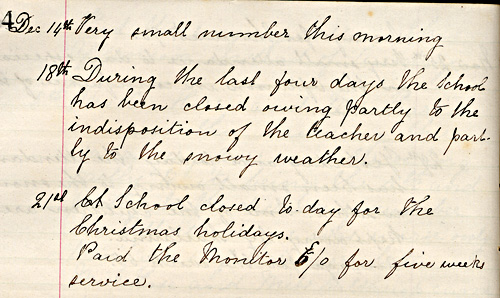
In 1911 The Saracen's Head, Dunstable offered refreshments to the traveller as well as catering for parties [ref.Z1130/36/109]:
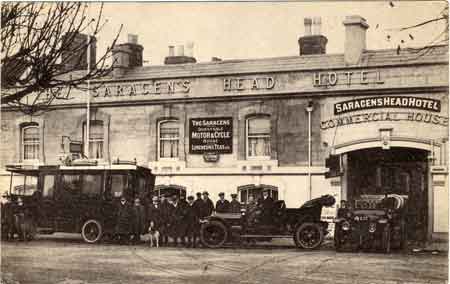
Thankfully we have more cheerful references to Christmas or plum puddings!
As post Christmas raffle prizes at Wootton in 1897 [ref.P3/28/6/3]:

Welcome gifts to troops on the front line in 1916, even though according to his letter Wilfred Hammond's custard left something to be desired ref.Z1360/1/40];
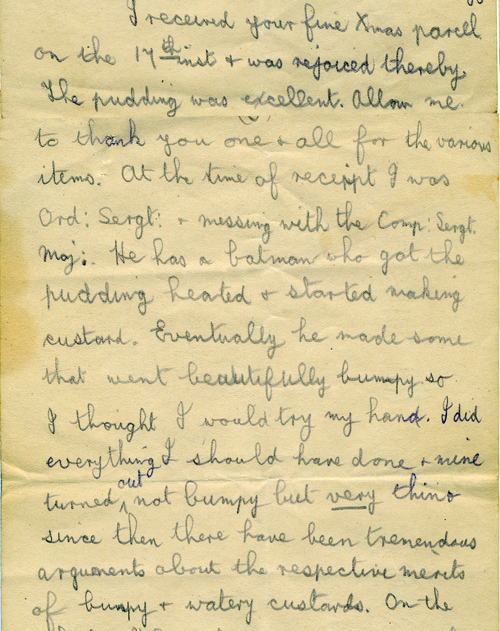
Family recipes – these are from the Hamerton family about 1840. The cherry pudding sounds good too! [ref.Z629/PW3/2]:
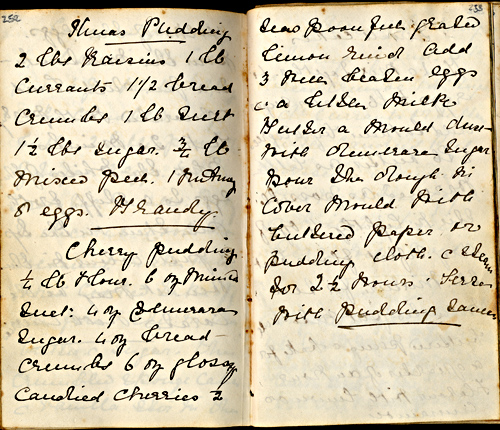
Comfort food for the sick – Bedford Hospital nurses, 1949 [BTNeg3916/6]:
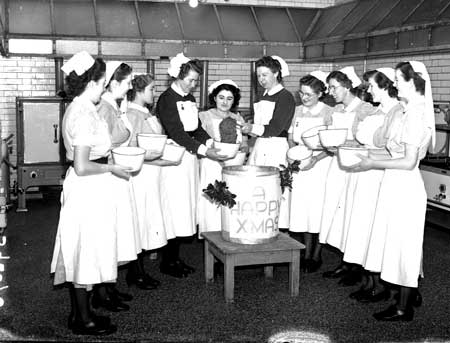
Seasons Greetings!